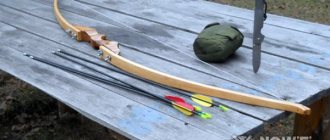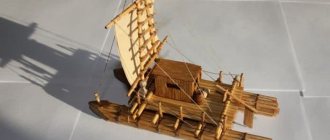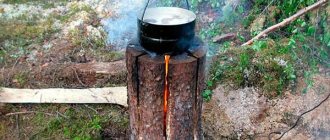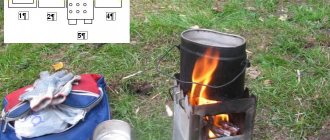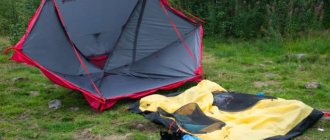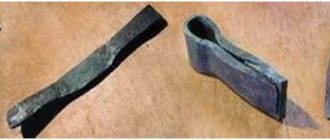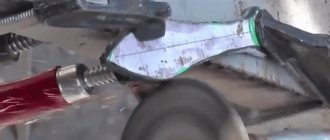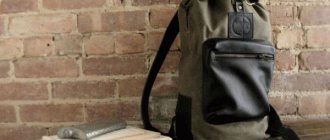A fire pit (also known as a fire pit) is a place that remains after a fire. It is also sometimes called a place specially equipped for lighting a fire.
A typical fire pit is in a small pit - after the camp is collapsed, it is covered with earth and leaves.
In the literature on tourism and survival, the issues of preparing and cleaning a fireplace are, at best, a few proposals. We will try to cover the topic of equipping a fire pit more fully by considering the following points:
- How to equip a safe and environmentally friendly fire pit for multiple fires;
- How to set up a place for a fire so as not to leave a fire pit and harm the soil;
- Where is it better to make a fire - on an old fire pit or to trample a new place for it;
- Which fires leave no traces of burning on the ground at all;
- What kind of barbecues, portable stoves and burners exist, including for hiking;
- How to put out a smoldering fire;
- What to do to easily relight a fire.
And some other nuances.
How to equip a safe and environmentally friendly fire pit for multiple fires?
In order not to harm either yourself or the environment, and not to add hassle to the Emergency Situations Ministry workers, when making a fire pit it is enough to follow simple instructions and follow a number of simple rules.
Let's list them and briefly analyze each:
- You should not light a fire on peat bogs , since, firstly, it is difficult to trace the beginning of a peat fire, and secondly, it is difficult to extinguish it. Thirdly, it can cause crown fires, taking the lives of those who find themselves in the forest along their path; I’m not talking about the damage that such fires cause to nature;
- It is necessary to clear the area at the site of the fire and nearby from flammable materials, which is especially important, for example, in a pine forest, where the entire forest floor consists of flammable pine needles, or in a summer steppe covered with dry vegetation;
- You should dig around the fire or make a fire pit out of stone or brick to avoid the fire spreading to dry vegetation. In the wild, this can be done simply by surrounding the fire with stones;
- It is often advisable to lay out the surface under the future fire from stone, so that nothing remains on the ground after the fire. However, for some types of fires this is not necessary: for example, a classic noya leaves no traces on the ground at all;
- If necessary, you should make a “screen”, for example, in the form of a fence made of sticks, or make a fire near a rock wall. Such a fire will provide more warmth to the person sitting in front of it. On the other hand, some types of fires, for example, a hunting fire, themselves shield heat due to their design, and some other types, for example, one of the variants of a wood stove, do not provide heat at all;
- If you plan to use the fire for cooking, you can drive wooden posts into the ground and place a long, even stick on them or hang a rope for the pots;
- To set up a permanent fire pit, it makes sense to make a canopy against precipitation; under the canopy, the fire will not be extinguished at the most inopportune moment;
- If there is an equipped place for a fire or a place with traces of a fire, it is better to light a fire in this place (if, of course, it meets the requirements of safety and convenience);
- In deep snow, it is better to make a buried fire pit by excavating the area to the ground, or build a wooden deck from parallel-laid logs so that the fire does not “drown” in a snowdrift. However, when using some types of fires, for example, taiga fires, there is no need for such actions: such a fire remains on the surface of the snow cover even after burning for a long time.
A fire on a log deck is a great way to avoid melting snow, causing the fire to sink, and scorching the ground.
Of course, in each specific case it is also necessary to take into account specific nuances that cannot be predicted in advance. For example, in a swampy area, you need to be able to choose a place for a fire pit so that it does not become flooded, and, for example, in a summer steppe, the entire fire pit must be cleared of dry grass in advance in order to prevent a steppe fire. These subtleties must be taken into account before starting a specific fire in a specific place.
Fire pit
Note. The word “bonfire” in most cases means a place for a fire in a country house or other place, made specifically for this purpose, or left after the combustion of fuel. This word can also mean a large fire.
What is it for
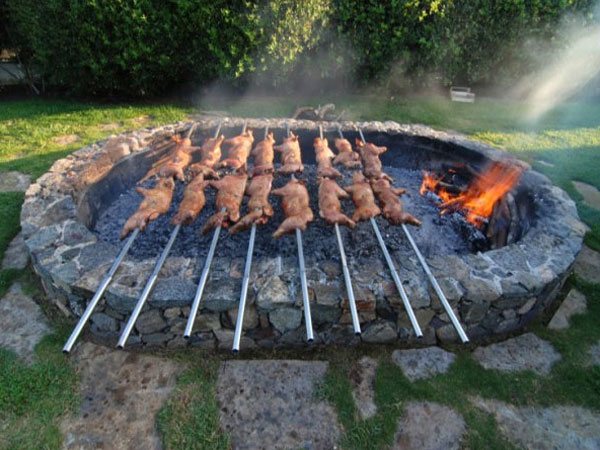
Fire pit for barbecue
An open fire in a suburban area is usually lit for three reasons:
- firstly, this is the usual disposal of unnecessary things and garbage;
- secondly - for aesthetic purposes, that is, to simply sit by an open fire in the fresh air;
- thirdly - for arranging a country barbecue or barbecue.
Of course, safety will come first and it doesn’t matter at all whether the country houses around are made of block containers, brick or wood - there will always be material that poses a fire hazard.
Of course, if you cook barbecue, you will use only firewood as fuel; it is also more likely that you will use wood for the aesthetic enjoyment of the fire. But when burning garbage, different materials can get there.
Therefore, you should make sure that explosive objects, for example, cans of paint and aerosols, do not get into the fire - the instructions warn about their explosiveness. You should also avoid burning rubber and plastic (bottles, bowls, toys, etc.) - the rubber will smoke, depositing flakes of soot on neighbors' property, and polymers release toxins when burned.
Arrangement options
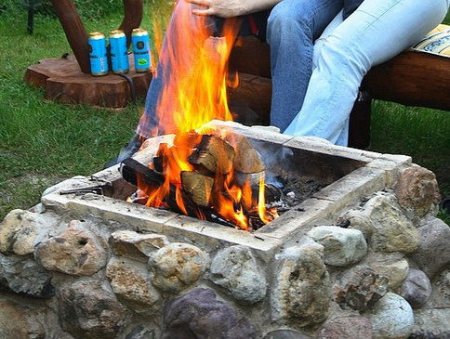
Open above ground hearth
- First of all, to equip a place for a fire, you will have to find a good place, which should be located away from a residential building, utility buildings and the crown of spreading trees.
- In addition, you should not use the lowest or highest points of your site - it is best if you stop at something in between and the site is open and clearly visible.
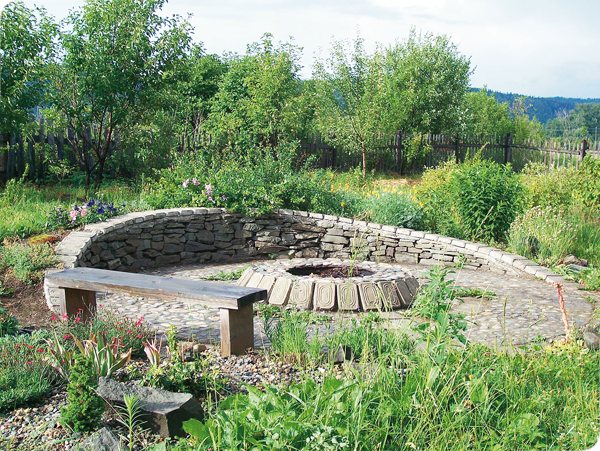
Resting-place
To arrange such country fireplaces, a round shape is most often used, but this is by no means the main requirement - it can also be:
- square;
- rectangle;
- and even a triangle.
The main thing is that its cross-section in the narrowest place where the firewood will burn is at least 40 cm. For a circle, a diameter of 80-100 cm is usually used, although this is not something mandatory.
Aboveground hearth
- As a rule, they are made with decorative trim. Although a metal rim can be inserted into the middle, its walls must be at least 1-1.5 mm, otherwise it will burn out. That is, a metal bowl will not work here.
- You can also install a concrete circle in the center, which you will then decorate with paving slabs, only you will need special mixtures with fireclay additives as an adhesive.
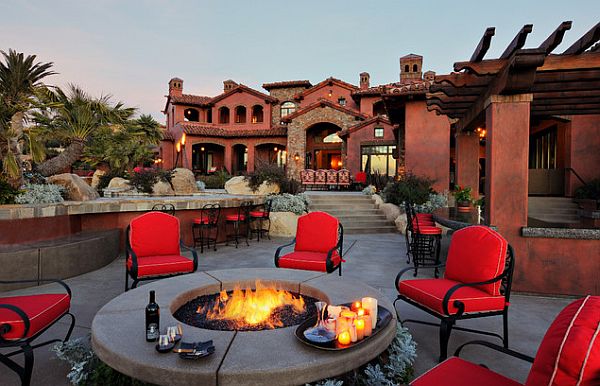
Fashionable hearth
- You can also lay out the walls from fireclay (fireproof) bricks; ordinary clay with the addition of fireclay powder is used to bind it.
- Or, instead of bricks, you can use granite cobblestones, which will be sufficiently firmly fixed in the ground or in a concrete screed, and small gaps between them do not need to be sealed at all - this will not interfere with combustion.
- The walls and the site itself can be finished with any facing materials that are not subject to melting and are not afraid of open fire.
Recessed hearth
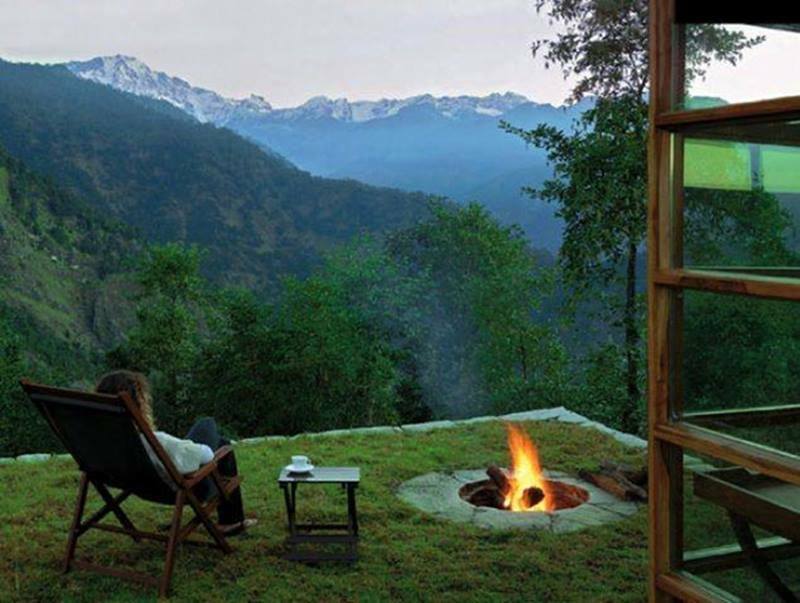
Recessed hearth
The technological design of the recessed hearth, which you see in the photo above, is very similar - similar materials are used there, and the cross-section of the fire pit itself does not differ from the above-ground version. The main difference is the aesthetic perception of the object and personal preferences.
Recessed hearth in section
To set up a buried fire pit:
- A hole is dug 30-40 cm deep and a cushion 15-20 cm high of fine crushed stone or granite screenings is poured into it (some use fine-grained expanded clay for this purpose).
- The walls can be laid from refractory bricks, hewn or simply smooth granite, using clay with fireclay powder for binding.
- You can also take a simpler route and place a concrete ring in the hole - the main thing is that the upper part of the walls is strictly horizontal. The bottom can be concreted.
The simplest hearth option
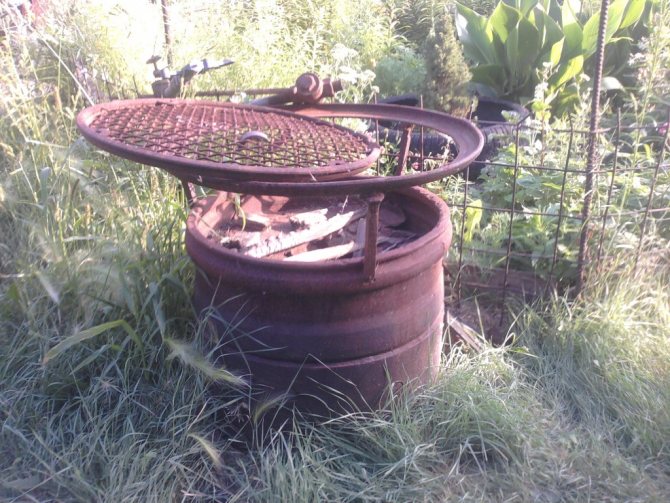
Steel barrel grill
The easiest way to make a fire pit in the country is to use an old steel barrel. Its walls should not be rusty, otherwise the metal will burn out very quickly.
There are two options here:
- The first is when you simply cut a circle 30-35 cm high and drive it into the ground, leaving 15-20 cm above the soil surface.
- The second, when a grate is welded 15-20 cm from the top, and a blower is cut below to create draft. You can weld a grill on top, as shown in the photo.
Note. If your suburban area is not electrified, then you will not feel complete comfort from relaxation even if you have a romantic fire pit. But you have a way out - renting a diesel generator for your dacha.
How to set up a fire pit so that there is no fire left?
There are many different ways to ensure that the ground after a fire is free of charcoal and ash residues that spoil the landscape, damage vegetation and, in some cases, reveal the presence of a person who, for example, wanted to remain unnoticed.
For example, for these purposes I most often remove the turf from the place where I plan to make a fire. The turf is removed in square pieces and laid not far from the fire, grass side down, in the order in which it was removed. After the fire has burned out, it should be extinguished with water, the coals should be scattered in an even layer throughout the pit and, after waiting for complete cooling, the previously removed turf should be laid on top of them. If the prepared site was made with a reserve in area, then it will be impossible to determine at first glance that someone was burning a fire in this place. If, on the contrary, the dug area is small in size, and the fire occupies its entire area, the uncut grass located around the perimeter will burn and will be noticeable against the background of the rest of the grass.
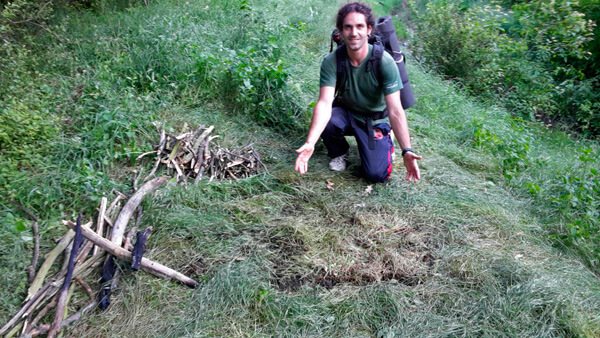
The turf has been removed and re-laid: it is clear that from a distance such a fire pit leaves virtually no traces.
You can also hide the place where the fire was burning by lighting it on stones tightly placed one next to the other. The cracks between the stones can be filled with pebbles or smaller stones to prevent coals from falling into them. However, such flooring is recommended to be done on rocks and not recommended to be done on grass, since stones heated from a fire will simply burn the grass, leaving noticeable marks.
Near the river, without unnecessary hassle, you can make a fire right on the shore not far from the water. During a rise in the river level, which in mountainous areas is observed even during the day due to the daily melting of snow on the mountain tops, the burnt out fire will simply be washed away by the current. However, in other areas, a fire pit can be washed away only during a spring flood or after another rainstorm.
If you have an axe, you can create a deck of logs with your own hands, on which to pour a layer of earth. A fire lit on such a site will not leave a fire pit on the ground, and the grass crushed from the logs will level out within a few days. Of course, upon leaving such a bivouac, the log flooring is removed, and the earth with cooled coals is scattered or buried.
In the end, a fireplace formed on the ground can simply be hidden by covering it with earth, leaves, placing a stone on top, or replacing the burnt-out area with exactly the same one, taken from another place, located to the side and hidden from prying eyes. But such a strategy of behavior is advisable only if all other options for some reason could not be implemented, and it is still necessary to somehow get rid of the consequences.
Selecting and preparing a place
First of all, the fire pit area must comply with fire safety regulations. The future hearth is installed at a distance of at least 4 meters from trees and bushes. The distance from residential buildings and utility structures is 3-3.5 meters.
Do not locate the fire zone directly next to fences dividing land plots, as smoke from the fire will cause inconvenience to neighbors. Do not install the future fireplace on hills, on the windward side. And especially do not set up a place for an open fire near a warehouse of flammable substances, gas cylinders and household chemicals.
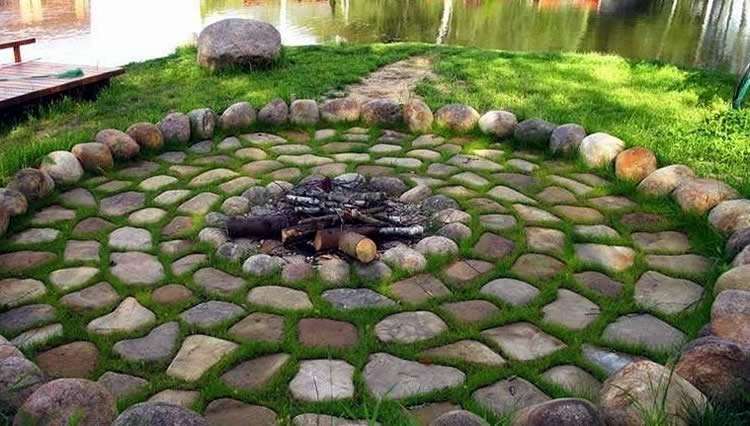
Bonfires that don't leave the fire pit
Some fires do not leave behind a fire pit, so when setting up a place for them, you only need to ensure fire safety.
Such fires, for example, include a knot made of two logs and a Finnish candle, or rather its variation, better known as a wooden primus stove.
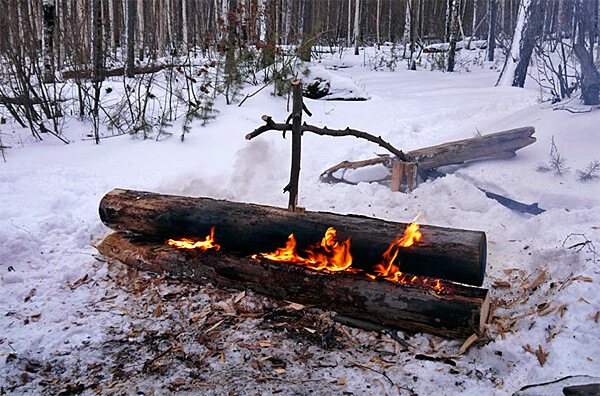
In such a node, the fire burns on the top log and neither the earth nor the snow underneath is burned.
Also, deepened fires - fires in a pit, such as trench, Polynesian and Dakota hearths - hardly leave fire pits. Why "almost"? Because flames rising from a hole in the ground above its level burn the soil and vegetation around the perimeter, leaving marks even after the hole itself has been buried.
Fire pit made from scrap materials
You can take a ready-made concrete flower plant and dig it into the ground or install it on a support. The result is a simple and cute fire pit. Another option involves the use of well rings . Operating procedure:
- Take two products of different diameters and place them on the ground so that the small one is inside the large one.
- Align the upper edges, deepening the product with a larger diameter.
- The space between the rings is filled with gravel, crushed stone or mortar.

The simplest open hearth can be easily constructed from a galvanized ring with a diameter of 90–120 cm. Prepare the site by digging a hole of the required depth and try on the ring. If it stands level, place bricks under it and push them a little into the ground. As a result, there should be gaps between the lower edge of the ring and the soil through which air should flow. If this is not provided for, the fire in the fireplace at the dacha will die out. It is not necessary to decorate such a fire pit.
a simple fire pit at your dacha with your own hands from an old wheel rim, a round basin without a bottom, or a section of a barrel. The principle of construction in all cases is the same as when using stone.
The main thing is to remember about fire safety, maintain dimensions and be careful. Then the hearth will turn out beautiful and safe.
0
( 1 ratings, average: 4.00 out of 5)
Back
Eschynanthus: home care and reproduction
MORE
Barbecues, portable stoves and burners
Barbecues and portable burners are another good way to avoid leaving behind the remains of a fire, since in this case the fuel burns not on the ground, but in a special device.
Those who like to relax in city parks, where it is prohibited to burn fires on the ground, most often take barbecues with them, but barbecues are not a popular thing among tourists. In the tourist community, kerosene stoves, gas, liquid and multi-fuel burners, as well as folding wood chip stoves and mini-stoves running on dry fuel are most often used as cooking equipment. They weigh significantly less than barbecues, and fuel burners do not require firewood and are used for hiking in the mountains above the forest zone, or for winter hiking, where a significant part of the route passes through sparsely wooded areas.
In the wild, from scrap materials (tin cans of different diameters) you can also build a pyrolysis oven that runs on wood chips and is used for cooking.
Also in tourism, special stoves are used to heat a tent or marquee, which can be folding or non-folding. Some of them weigh quite a lot and are sometimes even transported to the parking lot by transport, but there are also lightweight options that, when assembled, weigh only a few kilograms and can be carried in a backpack by one of the members of the hiking group.
The main beauty of such stoves is the ability to light a fire in them and cook food inside a tent or tent, that is, being protected from wind and snow. In addition, such stoves allow you to warm up the tent itself and even arrange a kind of camp bathhouse.
The stove of its own original design was carried with them by members of Dyatlov’s notorious tour group. Similar stoves are still the norm today for long winter hikes in the Subpolar and Polar Urals, since they are practically the only way to at least briefly relieve cold fatigue among tourists. Judging by the entries left in the diary, even the relatively heavy stove of the Dyatlov group coped well with its tasks, and lighter and more advanced modern options are even more excellent alternatives to fires, especially for use inside a tent.
How to put out a smoldering fire
The most commonly used methods of extinguishing a fire are to fill the fire pit with water and cover it with earth. The second option is advisable to use when there is a lack of water.
Your own urine can also be used for these purposes. And although such an act is not approved by many tourists, nevertheless, in conditions of survival I do not see anything wrong with it, especially if this is the only possible option to ensure fire safety.
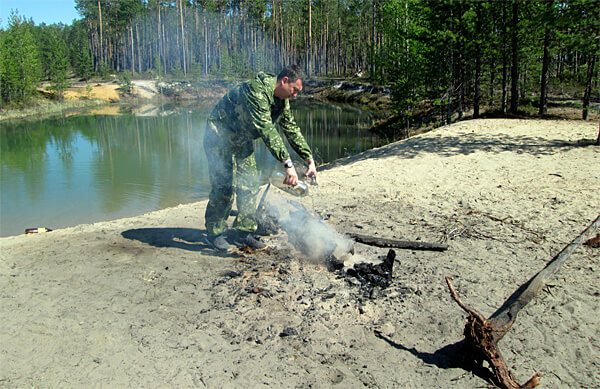
Before extinguishing a fire with water, you should rake the coals so that they do not lie in a pile. Otherwise, still hot coals lying nearby may flare up again.
Sometimes, to extinguish a fire surrounded by stones, it is enough to simply collect the unburnt fuel in one pile in advance and allow it to burn completely, then distribute the coals in an even layer over the area of the fire and wait for them to cool. If the burning logs are large enough to burn out quickly, for example, in the case of a node, they can be moved away from each other, which will quickly lead to the cessation of burning and smoldering, unless the logs were rotten (these can smolder for many hours). If you additionally water them, they will stop burning and smoldering even faster.
What to do to easily relight a fire pit
Typically, for a tourist, hunter or fisherman, lighting a fire on clay, stones or any other surface does not pose any problems. Most often, a round fire pit is equipped; stones are placed around the fire, which prevents the spread of fire. But it happens that you need to quickly relight the fire without using ignition tools. This can be done at the site of a burnt-out fire.
If, after using the fire, it becomes necessary again after a few hours, you can rake the smoldering coals into a pile (so they will smolder longer), and then use the smoldering coals to light a fire. But it’s still better not to leave the fire unattended.
Rotten wood (rotted dry rotten wood) or tinder fungus, which can smolder for a long time and produce fire when wrapped in kindling, will help to move the fire over a long distance or “preserve” it for several hours for further lighting of the fire.
If smoldering logs are moved one from another, their coals will go out, but in the near future they can flare up from one spark. More precisely, having caught a spark, the ember will begin to smolder. From it you need to light another ember from the same fire. And the smoldering coals already leaning against each other, when fanned, will give an open fire, from which the kindling can ignite.
If you have a large supply of cotton fabric, you can use it to make a burner - tinder that begins to smolder from the slightest spark, for example, carved by hitting a flint with a high-carbon steel knife. To do this, a piece of such fabric must be burned in a fire without access to air, for example, in a loosely closed tin can that can be found among the garbage. When the smoke and flames from the cracks of the can stop, this will mean that the burner is ready.
How can you determine from the fire pit how many days ago the fire was lit?
Determining the timing of a fire may be necessary when a lost person is trying to reach people. And a recently burned fire means that people may be very close, and it makes sense to go in search of them, try to call for help or in some other way indicate your presence to increase the chances of rescue.
However, it is unlikely that it will be possible to determine exactly how many days ago the fire was lit, that is, the time of the last stay of people at the site where the already cooled fire was found. But with a high probability, searching for people does not make much sense if:
- The place where the fire was was covered with snow, the closest snowfall was a couple of days ago, and no traces of people’s feet are visible in the snow;
- The place where the fire had previously been made and extinguished was covered with leaves; leaf fall had long passed, and the weather for the next few days was calm and windless;
- Foreign debris and dust appeared on the coals;
- The cans burned in the fire had become rusty;
- Fresh grass had managed to sprout at the site of the fire.
On the contrary, the freshness of the fire pit and the possible proximity of people can give away:
- A dying fire that has not been extinguished or has flared up again, or still smoldering coals of a fire;
- The ground that has not yet cooled down under the cooled coals;
- Dry coals and no snow on them, if rain, snowfall, fog or dew stopped only a few hours ago. In general, snow is a factor that makes it possible to accurately determine the time frame for burning a fire. If, for example, it is known exactly when the last snowfall or powder passed, but there is no snow on the fire found, then it is obvious that it was extinguished after the snowfall. Conversely, if the fire is covered with snow, it means that it was extinguished before the snowfall. With proper observation, you can sometimes even calculate from the thickness of the snow how many snowfalls have passed since the fire was extinguished;
- The freshness of leftover food lying near the fire, for example, crackers and cookies that have not had time to become damp, or the absence of flies and ants on sweets.
- The trampled green grass around the fireplace has not had time to straighten out.
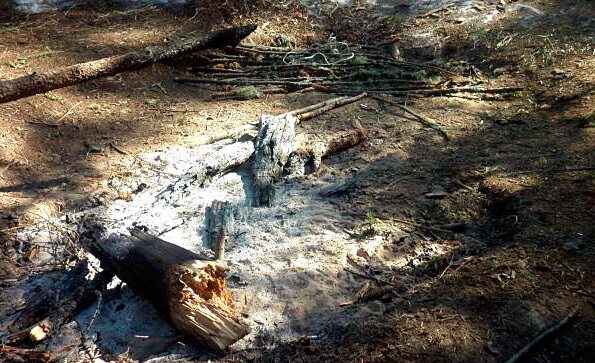
A fire pit where the fire had burned relatively recently—the fresh ash dust had not yet had time to be blown away by the wind.
Thus, although not exactly, it is still possible to determine when the fire was lit and to establish the approximate duration of other people’s stay at the site of the old fire, and therefore increase your chances of survival. At a minimum, if there were people in this place and calmly made a fire, it means that they came here and left from here in an orderly manner to civilization. Consequently, a surviving person can do the same, especially if he manages to find out where and how people went. In this case, the fireplace is the most noticeable and easily detectable trace of a person’s organized stay.
Simply put, knowledge about the fireplace and how to properly organize it, how to extinguish it and how to handle it, allows you to fully ensure fire safety, the ability, if desired, to hide your campsite with the remains of the fire or to determine the proximity of other people, thereby increasing their chances of survival, and also leave the natural area in the form in which it was before the arrival of man. This is important both on a picnic and on a hiking trip.
Author: Maxim Chechetov
Arrangement of the hearth
The center of the resulting area is intended for live fire. This is where they begin to arrange a place for the flame.
- Dig a hole up to half a meter deep. The larger the diameter of the future hearth, the deeper the fire pit should be installed.
- The sides of the recess are sealed with refractory bricks, and the bottom is sprinkled with coarse crushed stone.
- Stones, paving slabs or fire-resistant bricks are placed on the prepared soil around the fireplace.
- A little to the side they prepare a place for firewood, brushwood, and coal.
Don't forget about fire-fighting devices and accessories. Keep a bucket of sand and a poker near the fireplace; if the space for an open fire is large, purchase a fire extinguisher.
